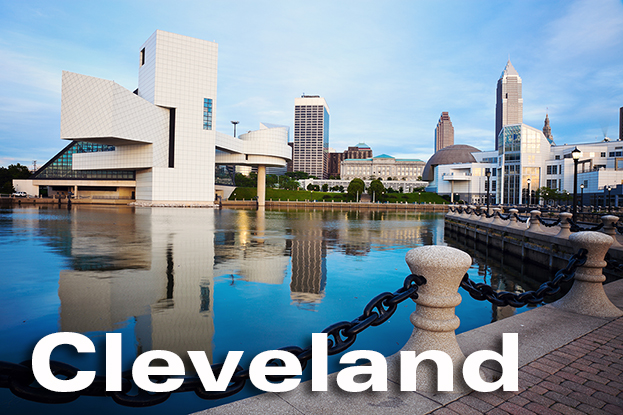
Cleveland, Ohio is a $170 billion industrial economy with manufacturing, healthcare, insurance and education industries. It is home to Cuyahoga County boasting a population of more than 1.2 million residents. The region has stable employment and a strong rental culture with attractive vacancy rates relative to the remarkably low acquisition price for residential homes. This, plus its remarkably low acquisition prices ($50,000 - $70,000) for single-family homes creates 9%+ cap rates and 18%+ cash on cash returns making it a solid income-producing region. The tradeoff for such strong investment performance is above-average crime rates, a slightly declining population and lower potential for asset appreciation. It is a cash flow investment market.
INVESTOR SCORECARD

AT A GLANCE
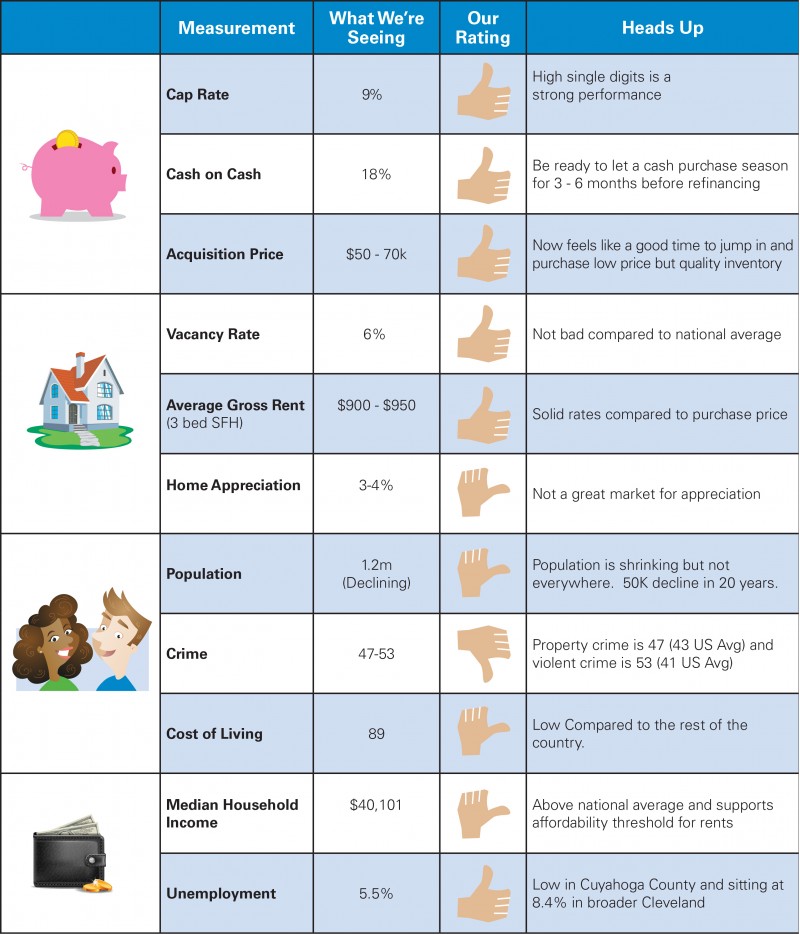
REGIONAL STATS
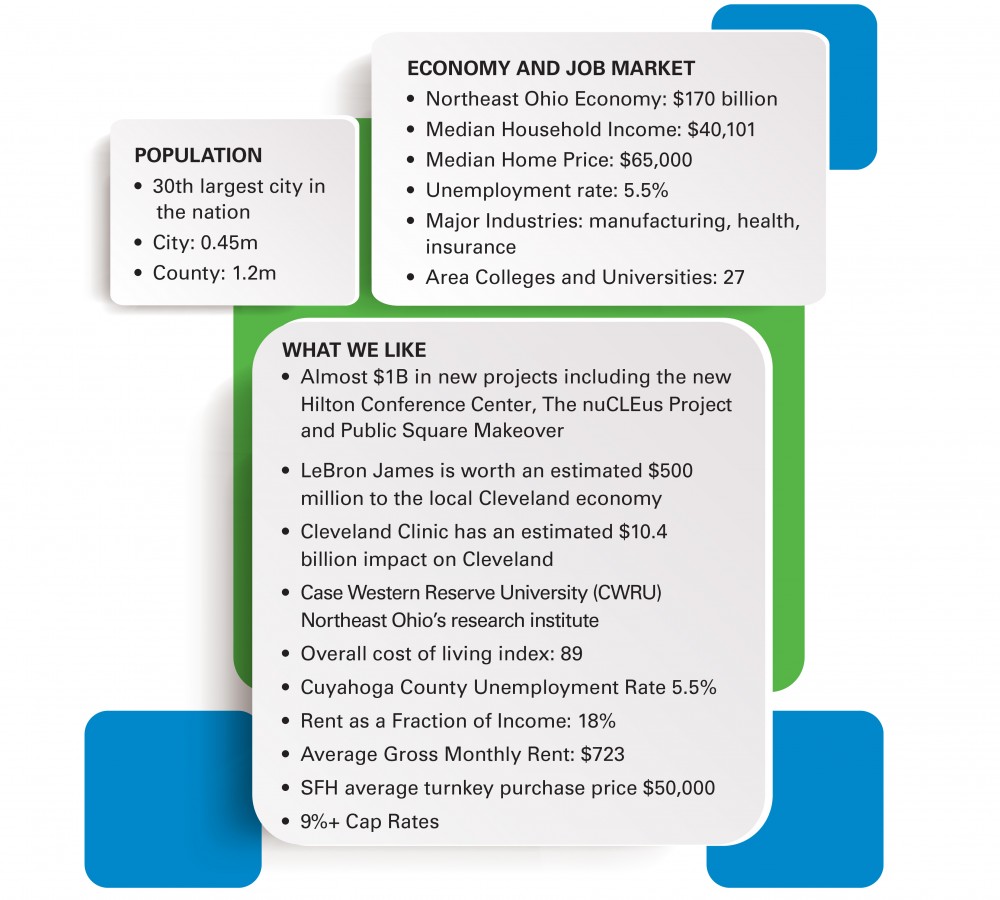
MARKET OVERVIEW
Cuyahoga County in Cleveland is in the northeast part of Ohio and is the largest and most populous of the state’s 88 counties. The shores of Lake Erie border the county to the north and the Cuyahoga River bisects the county. As the largest county in the state it boasts a population of more than 1.2 million residents. The county offers many amenities including an affordable cost of living, access to the second largest theater district outside of New York, and a multitude of museums and parks.
Its low tax system and investment-friendly climate has attracted businesses to establish local operations including 11 Fortune 500 companies headquartered in North Eastern Ohio and a growing health care economy. The median income for a household in the county is $43,603, and the median family income sits at $58,631. The unemployment rate is a healthy 5.5%. With low home prices and above-average rents it presents opportunities for turnkey single-family homes at around $50,000 - $70,000 with cash flow at $5,000 – $6,000 annually.
Economy
Diversified manufacturing is the primary industry in the local economy. Consistent with a nationwide trend the services industry, transportation, health, insurance, retailing, utilities, commercial banking and finance are emerging as a dominant sectors. Cleveland serves as headquarters to 11 companies on the Fortune 500 list, both industrial and non-industrial. These firms are, in order of their Fortune 500 rank: National City Corp.; Eaton Corp.; Parker Hannifin Corp.; Sherwin-Williams Co.; KeyCorp.; Nacco Industries; American Greetings Corp.; Ferro Corp.; Medical Mutual of Ohio; Applied Industries Technologies; and Lincoln Electric Holdings. Cleveland is also home to nearly 150 international companies from 25 different countries.
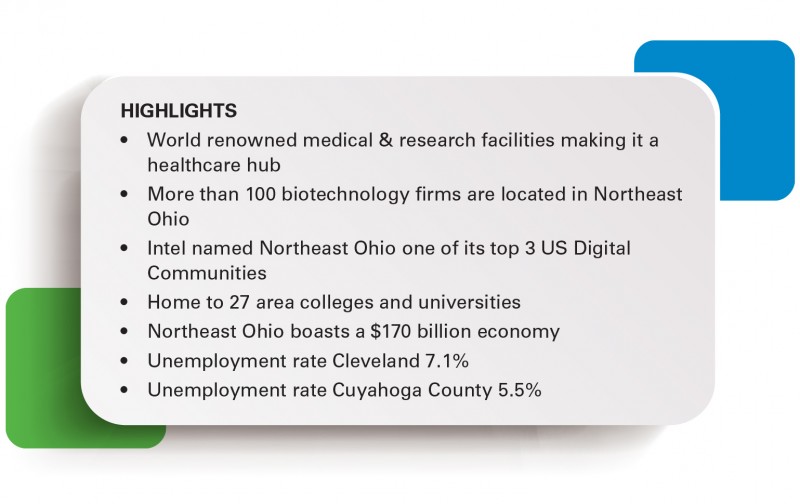
Cleveland Unemployment Rate
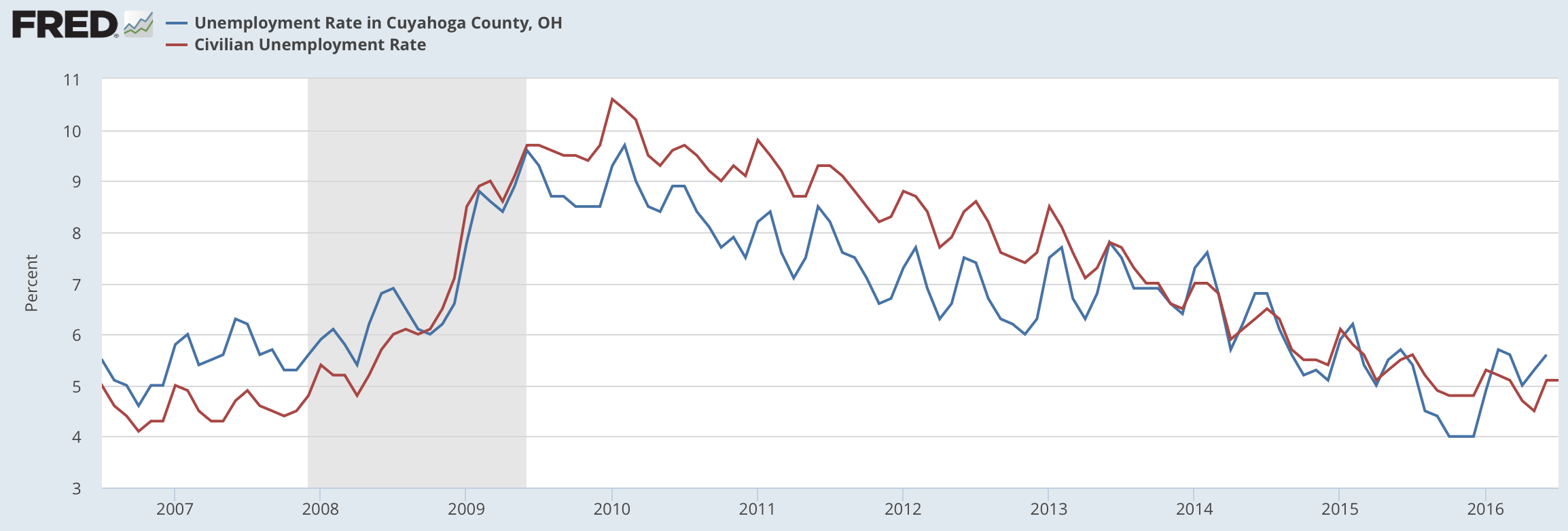
Local Redevelopment
There has been lots of news in Cleveland in the last 12 months and a spotlight in part due to the success of landing the 2016 Republican National Convention and new announcements invested almost a billion dollars in development to make Cleveland shine. Here are a few that you should know about:
The nuCLEus Project: The skyline of Cleveland will have a dramatic new structure in the future as the city of Cleveland recently approved the plans for the addition of a 54 story building (making it the city’s 4th tallest building). Immediately nicknamed The Jenga Tower, nuCLEus is a $400M project that will add one more large pocket of residential living in the downtown area, which is at 97% capacity and each new unit is rented the instant it’s available.

Photo courtesy NNBJ & Stark Enterprises
Public Square Makeover: The epicenter of downtown Cleveland, Public Square, underwent a $40M transformation after years of neglect. Spearheaded by the City of Cleveland’s Group Plan Commission, this reinvention of our town square removed all vehicular traffic from Ontario Street. It opened the week prior to 2016 RNC.
Photo renderings courtesy of James Corner Field Operations and The Group Plan Commission


The new Hilton Cleveland Convention Center: This was a $272M project that completed in 2016 in downtown Cleveland. The Cleveland Convention Center is deemed to be world-class.
Photo courtesy of Hilton Group
The Greater University Circle Initiative (GUCI): Is harnessing the power of The Cleveland Clinic, University Hospitals, and Case Western Reserve University who together spend almost $3 billion in goods and services annually to redevelop the local economy. Almost everyone who lives in Northeast Ohio has some connection to University Circle. The district, about four miles east of downtown Cleveland, is one of the largest employment drivers in Ohio, home to 17 major institutions and 60,000 full-time jobs—roughly one-eighth of all jobs in Cuyahoga County. The initiative is working on physical development and urban revitalization catalyzing transportation and real estate projects that reconnect neighborhoods. Research by a non-profit focused on sustainable redevelopment called The Democracy Collaborative documents the total investment leveraged from all sources at $4 billion.
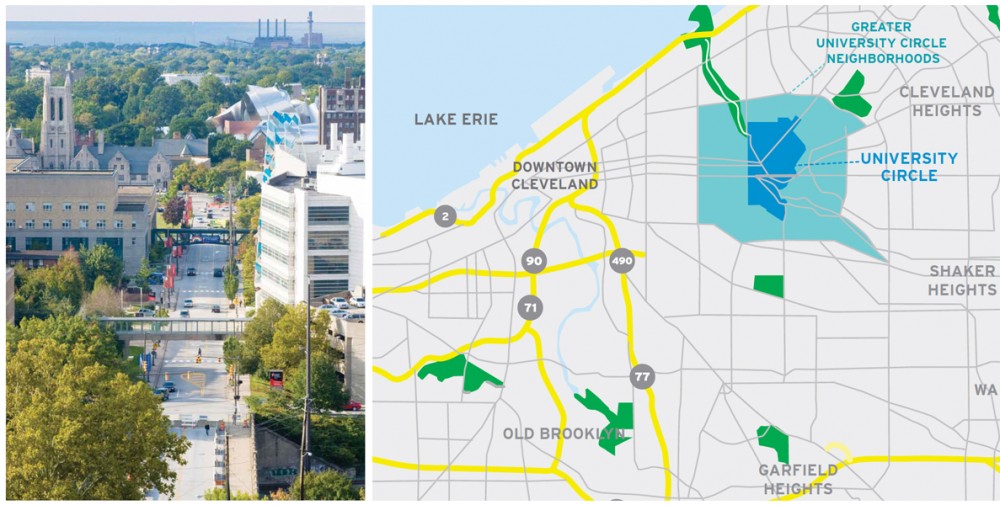
Photo courtesy of Cleveland Foundation
IMPORTANT QUESTIONS
Will It Rent?
We’ve had our eye on investing in the Cleveland, Ohio market for a few years. Right now there are plenty of attractive factors in this market, but the low price of inventory combined with reasonable vacancy rates and the lease fees are particularly appealing. Now this does depend on your definition of “reasonable” vacancy rates and these days, Cleveland is at 6.5% vacancy rate, which is slightly above the national average. The rental vacancy rate in Cleveland peaked in 2005 at 11.59%. Since then it has fallen by 5% to 6.5% according to Department of
Numbers data.
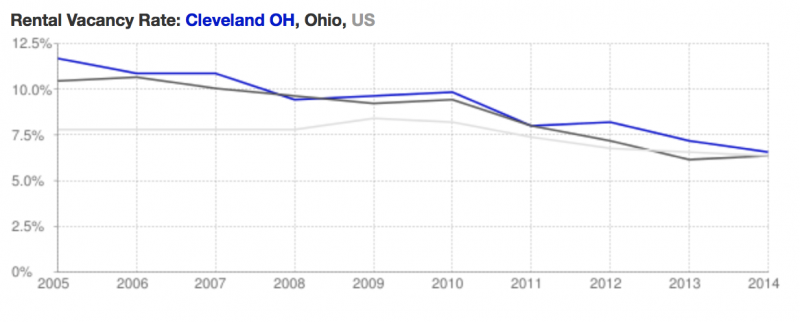
What Do Tenants Pay?
In 2012 the median monthly gross residential rent in Cleveland was $752 in 2014. We like three bedroom single-family homes that rent for around $900 - $950 per month.

What About Home Values?
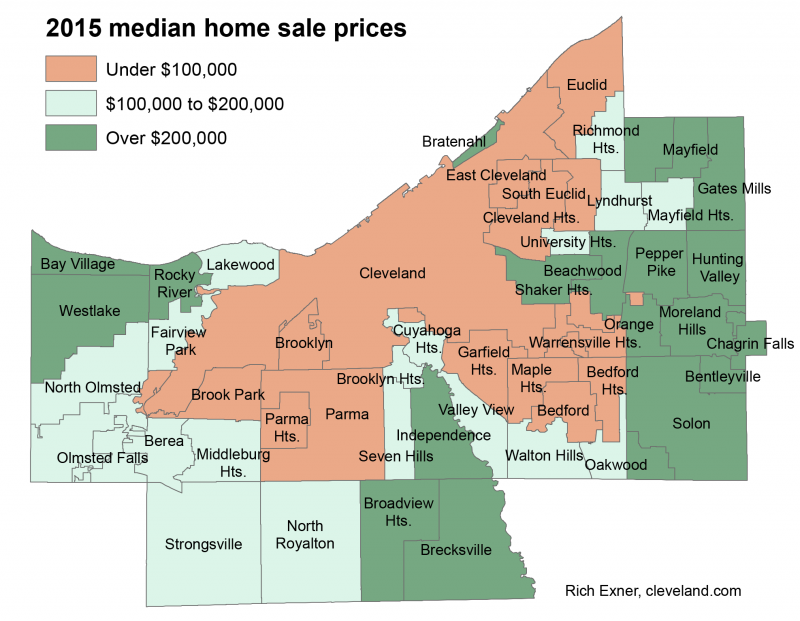
Low inventories continue to prevent some would-be buyers from making deals. Fewer homeowners and foreclosures were put on the market in 2016 when compared with listing-service figures from the prior year. Overall, new listings appear to be down.
What About the Population?
There are great investment opportunities within Cuyahoga County’s stable areas and around the borders of growing regions and areas in transition. Some of you may have heard the population in Cleveland is declining around 3-4% every 10 years. So why would we invest in a place where people are leaving? Well Cleveland is still losing some population but there are stable and growth areas.
There are investment opportunities on the borders of growing regions and transitional neighborhoods. For example, the Downtown and University Circle redevelopment has the potential to spread prosperity to places like Glenville and East Cleveland. Other neighborhoods like Cleveland Heights, Maple Heights, Warrenville and Garfield Heights offer real investment opportunities. We recommend avoiding the very poor parts of Cleveland like Hough, South Collinwood, St. Clair and Lee-Miles. In these kinds of neighborhoods there are few young people moving in.
Based on trends Cleveland’s population will probably shrink for the next 10 years, though not nearly the same as before. Although Cleveland’s population is shrinking and the decline is decelerating, the market is still very viable for cash flow real estate. If the current decline continues the 1.2m local population is forecast to be 1.15m in 20 years according to the Ohio Development Services Agency. If rental properties are maintained in good condition and priced appropriately for the local inhabitants the market is sizable enough for long-term passive income investing.
What About Crime?
Cuyahoga County property crime is 47 from a scale from 1 (low) to 100. Property crime includes the offenses of burglary, motor vehicle theft and arson. The object of the theft-type offenses is the taking of money or property, but there is no force or threat of force against the victims. The US average for property crime is 43. In Cuyahoga County violent crime is 53 on the same scale from 1 (low crime) to 100. Violent crime is composed of four offenses: murder; manslaughter; rape; robbery and aggravated assault. The US average for violent crime is 41. Given crime is higher than national average ensure your property manager professionally screens tenants. It’s also wisw to invest a little in good security practices like fitting dead bolts on all rentals and security lights to walkways.
THE BOTTOM LINE
Cleveland and Cuyahoga County have extremely favorable rental to home price ratios with high cap rates for single-family homes. The region has stable employment and a strong rental culture with attractive vacancy rates relative to the remarkably low acquisition price for residential real estate, which creates high cash-on-cash returns of 18%+ making it a solid income-producing region. The tradeoff for such strong investment performance is above-average crime rates, a slightly declining population and lower potential for asset appreciation. It’s all about strong cash flow.



